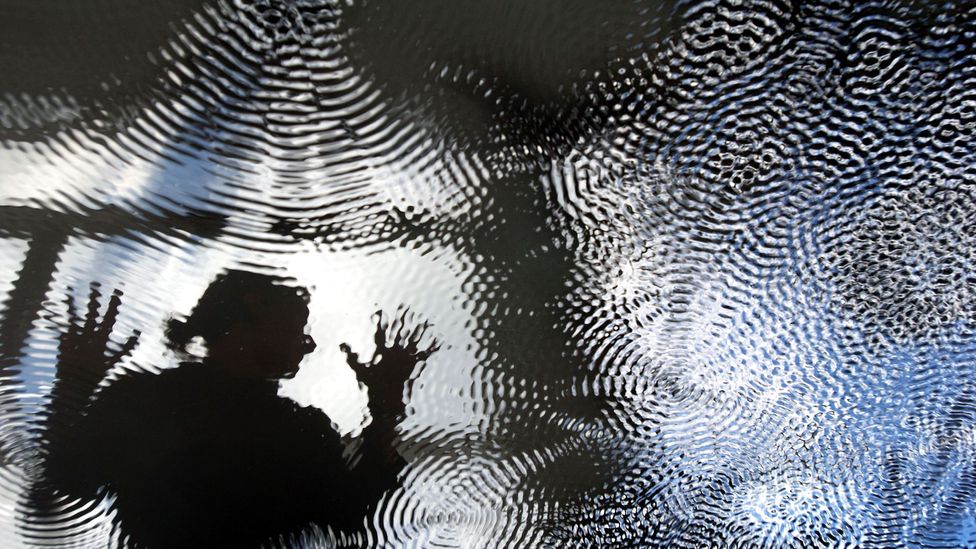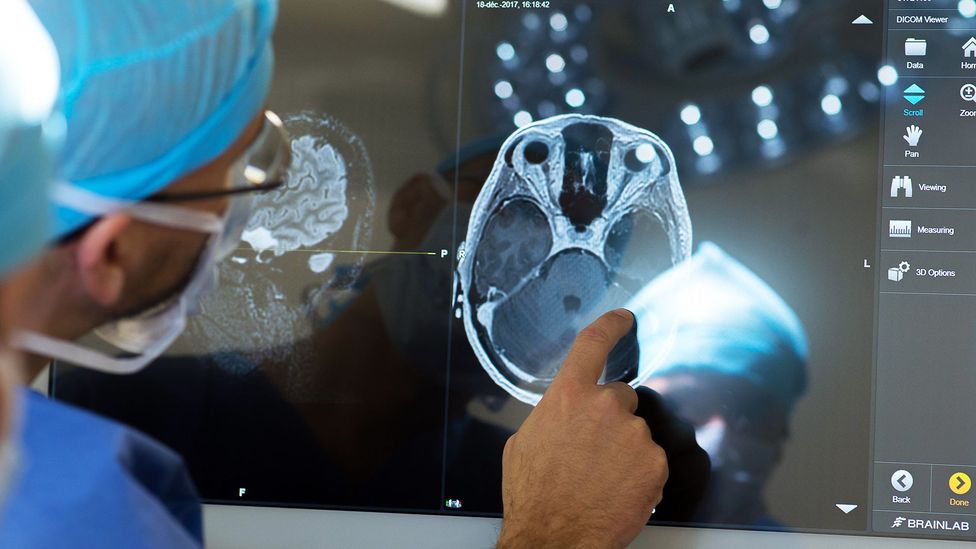Here We Go the Is on Again Many Voices to Hear and Some to Heed
Why yous tin can 'hear' words inside your caput

From The MIT Press Reader
When we have conscious thoughts, we tin ofttimes hear a voice inside our heads – at present new research is revealing why.
W
Why do nosotros include the sounds of words in our thoughts when we call up without speaking? Are they merely an illusion induced by our memory of overt speech?
These questions have long pointed to a mystery – one relevant to our endeavour to identify impossible languages — those that cannot take root in the human brain. This mystery is as relevant from a methodological perspective, since to address it requires radically changing our approach to the relationship between language and the brain. It requires shifting from identifying (by means of neuroimaging techniques) where neurons are firing to identifyingwhat neurons are firing when we engage in linguistic tasks.
Consider this uncomplicated question: what is language made of? Sure, language consists of words and rules of combination, but from the bespeak of view of physics, it exists in ii different physical spaces – outside our brain and inside it. When it lives exterior our brain, it consists of mechanical, acoustic waves of compressed and rarefied molecules of air – ie sound. When it exists inside our brain, it consists of electric waves that are the channel of communication for neurons. Waves in either instance. This is the concrete stuff of which language is physically fabricated.
There is ane obvious connexion between audio waves and the brain. Sound is what allows the contents of ane brain, as expressed in words, to enter another brain. There are, of class, other ways for two brains to exchange linguistic data – through the optics, via sign linguistic communication, or through tactile systems such as Braille or the Tadoma Method, for case.
Sound enters us through our ears, traveling across the tympanic membrane, the iii tiniest bones in our body known as the ossicles, and the Corti organ in the cochlea – a snail-shaped organ that plays a crucial role in this procedure. This complex system translates the acoustic signal's mechanical vibrations into electrical impulses in a very sophisticated mode, decomposing the complex audio waves into the basic frequencies that characterise them. The different frequencies are and then mapped onto dedicated slots in the principal auditory cortex, at which bespeak the audio waves are replaced by electric waves.

Non all linguistic communication uses soundwaves to communicate – braille relies upon the sense of impact (Credit: Alamy)
At to the lowest degree since the pioneering work of Nobel Prize-winning electrophysiologist Lord Edgar Adrian we have known that no concrete signal is ever completely lost when it reaches the brain. What nosotros've more than recently discovered is surprising: apparently electric waves preserve the shape of their corresponding sound waves in non-audio-visual areas of the brain, such as in the Broca's area, the part of the brain responsible for voice communication product.
These findings shed important light on the relationship between sound waves and electric waves in the brain, just almost all of them rely on one aspect of the neuropsychological processes related to language: namely, sound emission decoding. Even so nosotros know that linguistic communication can also be present in the absence of sound, when we read (but equally most of you are probably experiencing at this very moment) or when nosotros use words while thinking – in technical terms, when nosotros engage in endophasic activity.
This uncomplicated fact immediately raises the post-obit crucial question: what happens to the electric waves in our brain when we generate a linguistic expression without emitting any sound?
In 2014, my colleagues and I gear up out in search of answers. We compared the shape of the electric waves characterising the activeness in the Broca's area with the shape of the sound waves, not just when speakers were hearing audio, only also when they were reading linguistic expressions in accented silence – that is, when the input was not audio-visual at all.
Analysing inner speech is not a novel idea in neuropsychology, as we know from sources ranging from the Soviet psychologist Lev Vygotsky'south speculations on psychological development to analyses based on neuroimaging. Merely the technique we used to explore this miracle was unusual and illuminating, and the results were unexpected, to say the least.
In our experiment, data were nerveless by means of so-called awake surgery. This technique offers the possibility of stimulating and analysing the electrophysiological cortical activeness of patients who accept been awakened afterwards a portion of their skullcap was removed. The invasive nature of this technique, the fragility of the organ involved, and the cooperation of patients in an extremely delicate emotional state make this research very difficult for obvious psychological, technical, and ethical reasons.
The surgeon who cuts the cerebral cortex to remove a tumour, for case, cannot know in advance (except in specific cases) whether cutting the cognitive tissue will interrupt a neuronal network and thus impair or destroy a cognitive, motor, or perceptual chapters that is supported or conveyed by that network. To minimise any potential damage from the surgery, then, in one case the patient has been anaesthetised and a portion of the skullcap has been removed to admission the surgical site, the surgeon wakes the patient for a curt transitional period of most x to 20 minutes and asks him or her to perform some simple tasks that should require their utilising the exposed cortex.
You might also like:
- The surprising power of reading aloud
- What the vox inside your head says about you
- How to alive with 100 voices in your head
Every bit they perform them, the surgeon stimulates the patient's cortex by means of small electrodes, which causes no pain since at that place are no pain receptors in the brain. If the electrical stimulation in a certain portion of the cortex interferes with the operation of a given task, the surgeon knows that cutting that fragment of cortex could permanently damage the patient and can evaluate whether an alternative surgical site is bachelor.

Stimulating the brain during "awake surgery" has allowed surgeons to determine the role of different networks of neurons (Credit: Alamy)
The patient gains an invaluable advantage from these exercises, and one that is practically impossible to obtain through whatsoever other technique. At the aforementioned time, this technique provides u.s. with a unique opportunity to investigate brain operation and obtain extremely important data.
Outset, the surgeon can establish the position where a crucial node of a neuronal network associated with a specific chore is located in any given patient, which neutralises one of the major problems related to neuroimaging techniques – the fact that subjects may vary considerably equally to precisely where a certain function is carried out in the brain. The surgeon can also record with progressive precision neuronal electrical action downwards to the level of a single neuron – although this level is just reached in extremely rare cases with current technology.
This technique has increasingly been used for pathologies other than focal lesions – for example, cases of pharmacologically intractable epilepsy. In such cases, the surgeon tin also implant temporary electrodes that, once the skullcap has been airtight, provide continuous information for a lengthy period of time in an everyday environment, and information that is not limited to the telescopic of the operating room. This measuring method offers united states a further pace forwards in comprehending the neurophysiological processes taking identify in the brain. It provides a more precise and divers level of spatial resolution than what neuroimaging techniques are capable of and provides specific measures of electrical activity not available through indirect other means of measurement.
Allow the states now turn back to our experiment. Xvi patients were asked to read linguistic expressions aloud, either isolated words or full sentences. We then compared the shape of the audio-visual waves with the shape of the electric waves in the Broca'south area and observed a correlation (which was not unexpected).
The second step was crucial. We asked the patients to read the linguistic expressions again, this fourth dimension without emitting any sound – they merely read them in their mind. By illustration, we compared the shape of the audio-visual wave with the shape of the electric wave in the Broca's area. I should note that a signal was indeed entering the brain, but it was not a audio signal – instead, it was the light indicate carried past electromagnetic waves, or, to put it more simply, a indicate conveyed past the alphabetical messages nosotros use to correspond words (ie writing) but definitely non an acoustic moving ridge.
Remarkably, we found that the shape of the electric waves recorded in a not-acoustic area of the brain when linguistic expressions are existence read silently preserves the same structure every bit those of the mechanical audio waves of air that would take been produced if those words had actually been uttered. The two families of waves where language lives physically are then closely related – so closely in fact that the two overlap independently of the presence of sound.
The audio-visual information is not implanted later, when a person needs to communicate with someone else, it is part of the code from the beginning, or at least before the production of sound takes place. Information technology also excludes that the sensation of exploiting sound representation while reading or thinking with words is just an illusory artifact based on a remembrance of the overt speech.
The discovery that these 2 independent families of waves of which language is physically made strictly correlate with each other – even in not-acoustic areas and whether or not the linguistic structures are actually uttered or remain within the mind of an individual – indicates that sound plays a much more central role in linguistic communication processing than was previously thought.
It is equally if this unexpected correlation provided u.s. with the missing piece of a "Rosetta stone" in which two known codes – the sound waves and the electric waves generated past audio – could exist exploited to decipher a tertiary one, the electric code generated in the absenteeism of sound, which in turn could hopefully lead to the discovery of the "fingerprint" of man language.

The brain waves associated with processing language bear more than than a passing resemblance to sound waves (Credit: Getty Images)
Among the questions this discovery raises is what kind of electrical activity is elaborated in a language network (one that includes the Broca's surface area) past persons who have never been able to hear any sound from birth? Tin nosotros exploit electro-cortical information to access the linguistic thinking of aphasic patients whose articulatory appliance solitary has been damaged, and hear them speak again, albeit through an artificial device? Tin can we go a better understanding of linguistic communication used in dreaming or in patients who are in a minimally conscious state? Can we consider severe stuttering as a form of miscoordination betwixt different sound representations in different networks and hope to arbitrate and cure it? Can these discoveries lead to an unethical use of devices to excerpt linguistic idea from people who do non want to communicate it?
The very fact that the majority of human communication takes place via waves may not be a casual fact – after all, waves constitute the purest system of communication since they transfer information from one entity to the other without changing the structure or the composition of the two entities. They travel through us and leave us intact, simply they permit u.s. to interpret the message borne by their momentary vibrations, provided that we have the central to decode it. It is not at all accidental that the term information is derived from the Latin rootforma (shape) – to inform is to share a shape.
In his Philosophical Investigations, Ludwig Wittgenstein asked: "Is it conceivable that people should never speak an audible language, only should nevertheless talk to themselves inwardly, in the imagination?" The results of this experiment unexpectedly revive this prophetic question under a new calorie-free, and more chiefly, they advise new questions altogether.
* This commodity originally appeared in The MIT Press Reader, and is republished with permission. Andrea Moro is Professor of General Linguistics at the Academy Schoolhouse for Advanced Report (IUSS)in Pavia, Italy. He is the author of several books, including " The Boundaries of Babel ", " A Cursory History of the Verb To Be ," and " Incommunicable Languages ," from which this commodity is adapted.
--
Join one million Future fans past liking us on Facebook , or follow usa on Twitter or Instagram .
If yous liked this story, sign up for the weekly bbc.com features newsletter , called "The Essential List". A handpicked selection of stories from BBC Future , Culture , Worklife , and Travel , delivered to your inbox every Friday.
burnshuserapposse.blogspot.com
Source: https://www.bbc.com/future/article/20200929-what-your-thoughts-sound-like
0 Response to "Here We Go the Is on Again Many Voices to Hear and Some to Heed"
Post a Comment